Exploring Risk and Protective Factors in Youth Offending Patterns
VerifiedAdded on 2023/06/07
|8
|1913
|92
Report
AI Summary
This report examines the theories of crime by focusing on risk and protective factors associated with youth offending, particularly how these factors contribute to habitual offending patterns. It defines risk factors as elements that increase the likelihood of criminal activity, such as racism, unemployment, and drug abuse, while protective factors are positive influences like good schooling, family support, and engagement in social activities. The report analyzes how these factors affect young people and contribute to adult offending, referencing studies that identify key influences, including social life, school environment, and mental health. It emphasizes the importance of early identification of risk factors to enable timely intervention by public services, citing examples of social media-related offenses and the need for monitoring and legal frameworks. The conclusion highlights the necessity of preventive policies to address youth crime and ensure community safety.
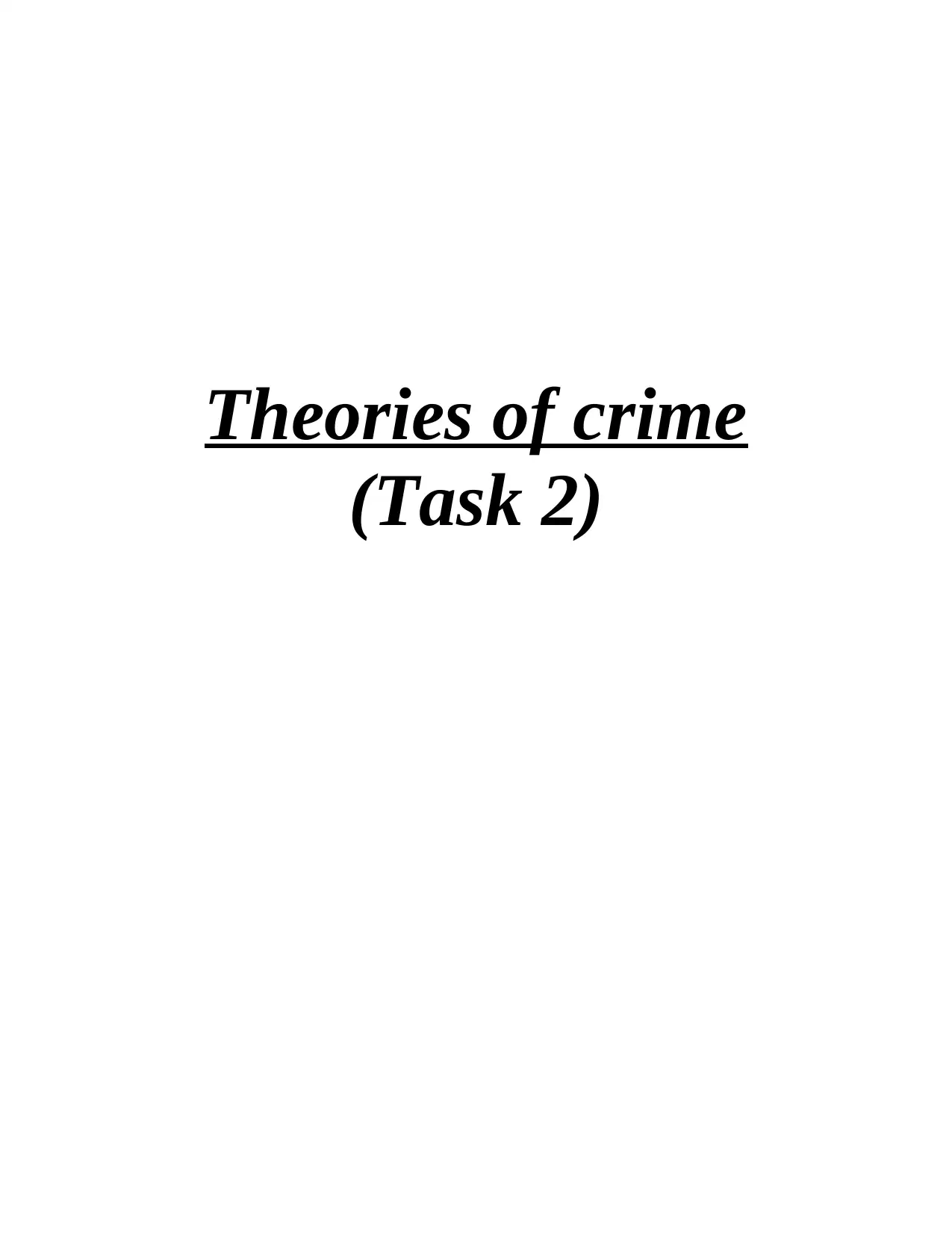
Theories of crime
(Task 2)
(Task 2)
Paraphrase This Document
Need a fresh take? Get an instant paraphrase of this document with our AI Paraphraser

Table of Contents
INTRODUCTION ..........................................................................................................................2
Researched definitions of risk factors and protective factors with examples;.................................3
Analyse researched risk and protective factors that are associated to young people offending and
why they are important to patterns of adult offending supported with appendices;........................4
A critical evaluation of why it is important to identify risk and protective factors early and how
this can aid public services;.............................................................................................................5
CONCLUSION ...............................................................................................................................6
REFERENCES................................................................................................................................8
INTRODUCTION ..........................................................................................................................2
Researched definitions of risk factors and protective factors with examples;.................................3
Analyse researched risk and protective factors that are associated to young people offending and
why they are important to patterns of adult offending supported with appendices;........................4
A critical evaluation of why it is important to identify risk and protective factors early and how
this can aid public services;.............................................................................................................5
CONCLUSION ...............................................................................................................................6
REFERENCES................................................................................................................................8
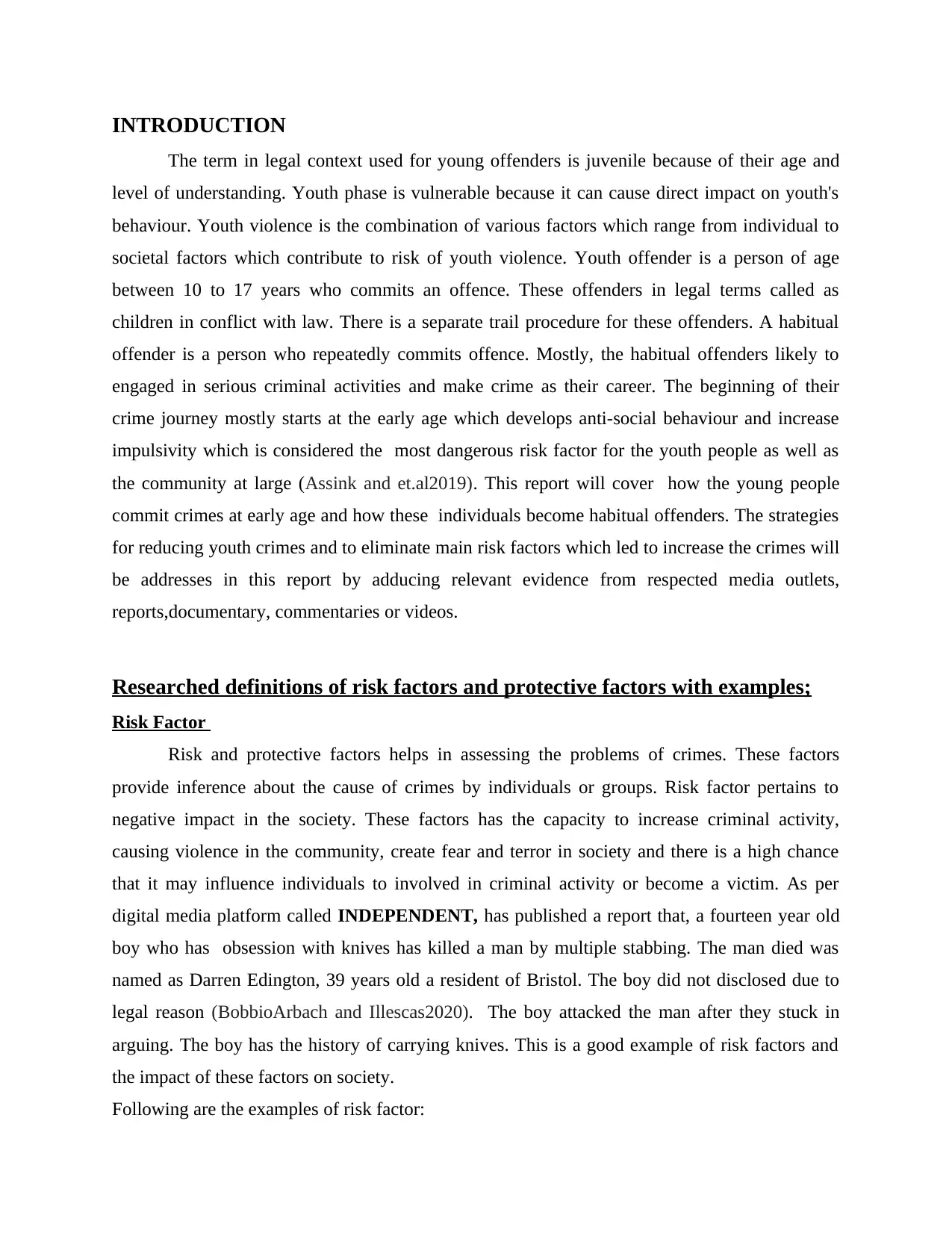
INTRODUCTION
The term in legal context used for young offenders is juvenile because of their age and
level of understanding. Youth phase is vulnerable because it can cause direct impact on youth's
behaviour. Youth violence is the combination of various factors which range from individual to
societal factors which contribute to risk of youth violence. Youth offender is a person of age
between 10 to 17 years who commits an offence. These offenders in legal terms called as
children in conflict with law. There is a separate trail procedure for these offenders. A habitual
offender is a person who repeatedly commits offence. Mostly, the habitual offenders likely to
engaged in serious criminal activities and make crime as their career. The beginning of their
crime journey mostly starts at the early age which develops anti-social behaviour and increase
impulsivity which is considered the most dangerous risk factor for the youth people as well as
the community at large (Assink and et.al2019). This report will cover how the young people
commit crimes at early age and how these individuals become habitual offenders. The strategies
for reducing youth crimes and to eliminate main risk factors which led to increase the crimes will
be addresses in this report by adducing relevant evidence from respected media outlets,
reports,documentary, commentaries or videos.
Researched definitions of risk factors and protective factors with examples;
Risk Factor
Risk and protective factors helps in assessing the problems of crimes. These factors
provide inference about the cause of crimes by individuals or groups. Risk factor pertains to
negative impact in the society. These factors has the capacity to increase criminal activity,
causing violence in the community, create fear and terror in society and there is a high chance
that it may influence individuals to involved in criminal activity or become a victim. As per
digital media platform called INDEPENDENT, has published a report that, a fourteen year old
boy who has obsession with knives has killed a man by multiple stabbing. The man died was
named as Darren Edington, 39 years old a resident of Bristol. The boy did not disclosed due to
legal reason (BobbioArbach and Illescas2020). The boy attacked the man after they stuck in
arguing. The boy has the history of carrying knives. This is a good example of risk factors and
the impact of these factors on society.
Following are the examples of risk factor:
The term in legal context used for young offenders is juvenile because of their age and
level of understanding. Youth phase is vulnerable because it can cause direct impact on youth's
behaviour. Youth violence is the combination of various factors which range from individual to
societal factors which contribute to risk of youth violence. Youth offender is a person of age
between 10 to 17 years who commits an offence. These offenders in legal terms called as
children in conflict with law. There is a separate trail procedure for these offenders. A habitual
offender is a person who repeatedly commits offence. Mostly, the habitual offenders likely to
engaged in serious criminal activities and make crime as their career. The beginning of their
crime journey mostly starts at the early age which develops anti-social behaviour and increase
impulsivity which is considered the most dangerous risk factor for the youth people as well as
the community at large (Assink and et.al2019). This report will cover how the young people
commit crimes at early age and how these individuals become habitual offenders. The strategies
for reducing youth crimes and to eliminate main risk factors which led to increase the crimes will
be addresses in this report by adducing relevant evidence from respected media outlets,
reports,documentary, commentaries or videos.
Researched definitions of risk factors and protective factors with examples;
Risk Factor
Risk and protective factors helps in assessing the problems of crimes. These factors
provide inference about the cause of crimes by individuals or groups. Risk factor pertains to
negative impact in the society. These factors has the capacity to increase criminal activity,
causing violence in the community, create fear and terror in society and there is a high chance
that it may influence individuals to involved in criminal activity or become a victim. As per
digital media platform called INDEPENDENT, has published a report that, a fourteen year old
boy who has obsession with knives has killed a man by multiple stabbing. The man died was
named as Darren Edington, 39 years old a resident of Bristol. The boy did not disclosed due to
legal reason (BobbioArbach and Illescas2020). The boy attacked the man after they stuck in
arguing. The boy has the history of carrying knives. This is a good example of risk factors and
the impact of these factors on society.
Following are the examples of risk factor:
⊘ This is a preview!⊘
Do you want full access?
Subscribe today to unlock all pages.

Trusted by 1+ million students worldwide
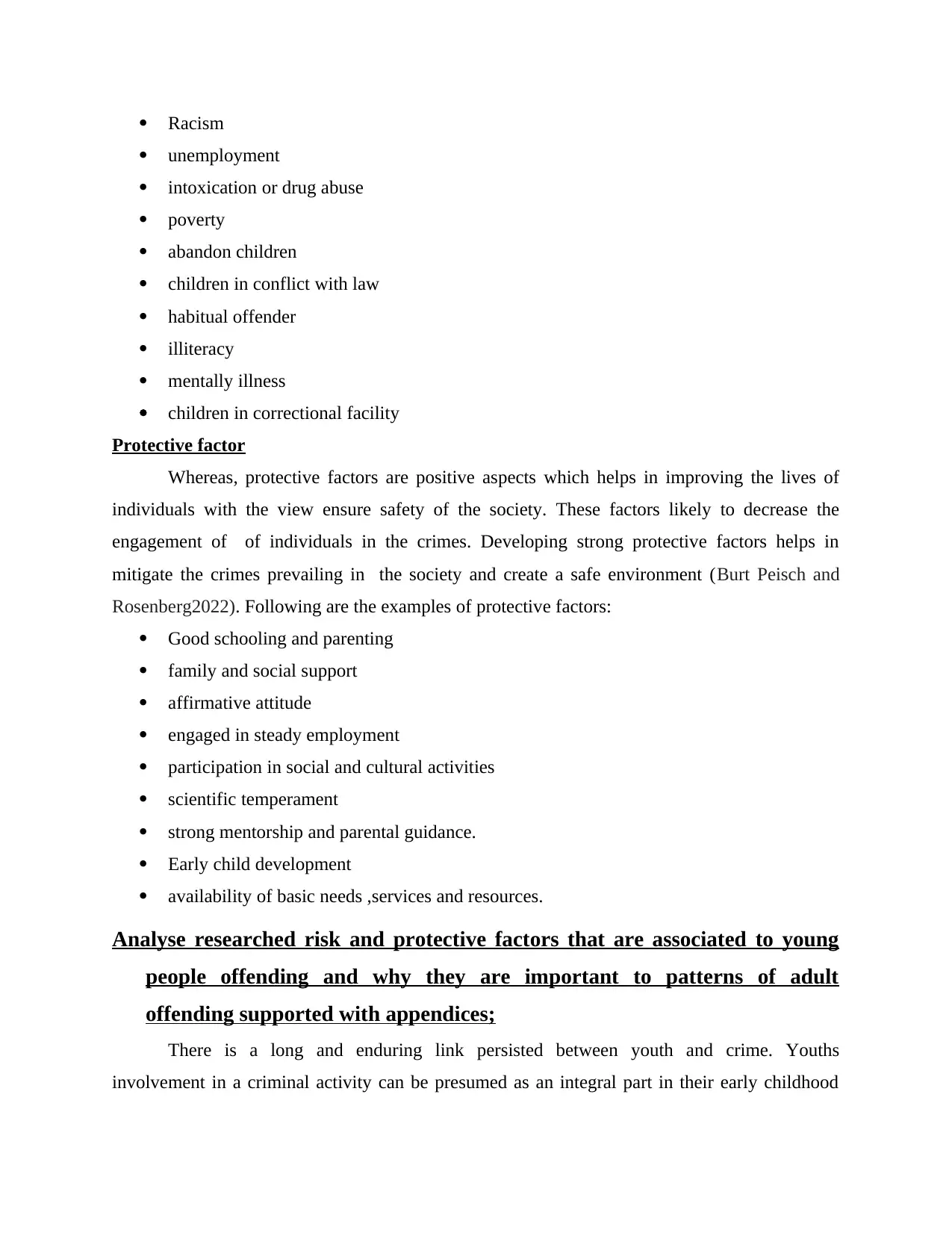
Racism
unemployment
intoxication or drug abuse
poverty
abandon children
children in conflict with law
habitual offender
illiteracy
mentally illness
children in correctional facility
Protective factor
Whereas, protective factors are positive aspects which helps in improving the lives of
individuals with the view ensure safety of the society. These factors likely to decrease the
engagement of of individuals in the crimes. Developing strong protective factors helps in
mitigate the crimes prevailing in the society and create a safe environment (Burt Peisch and
Rosenberg2022). Following are the examples of protective factors:
Good schooling and parenting
family and social support
affirmative attitude
engaged in steady employment
participation in social and cultural activities
scientific temperament
strong mentorship and parental guidance.
Early child development
availability of basic needs ,services and resources.
Analyse researched risk and protective factors that are associated to young
people offending and why they are important to patterns of adult
offending supported with appendices;
There is a long and enduring link persisted between youth and crime. Youths
involvement in a criminal activity can be presumed as an integral part in their early childhood
unemployment
intoxication or drug abuse
poverty
abandon children
children in conflict with law
habitual offender
illiteracy
mentally illness
children in correctional facility
Protective factor
Whereas, protective factors are positive aspects which helps in improving the lives of
individuals with the view ensure safety of the society. These factors likely to decrease the
engagement of of individuals in the crimes. Developing strong protective factors helps in
mitigate the crimes prevailing in the society and create a safe environment (Burt Peisch and
Rosenberg2022). Following are the examples of protective factors:
Good schooling and parenting
family and social support
affirmative attitude
engaged in steady employment
participation in social and cultural activities
scientific temperament
strong mentorship and parental guidance.
Early child development
availability of basic needs ,services and resources.
Analyse researched risk and protective factors that are associated to young
people offending and why they are important to patterns of adult
offending supported with appendices;
There is a long and enduring link persisted between youth and crime. Youths
involvement in a criminal activity can be presumed as an integral part in their early childhood
Paraphrase This Document
Need a fresh take? Get an instant paraphrase of this document with our AI Paraphraser
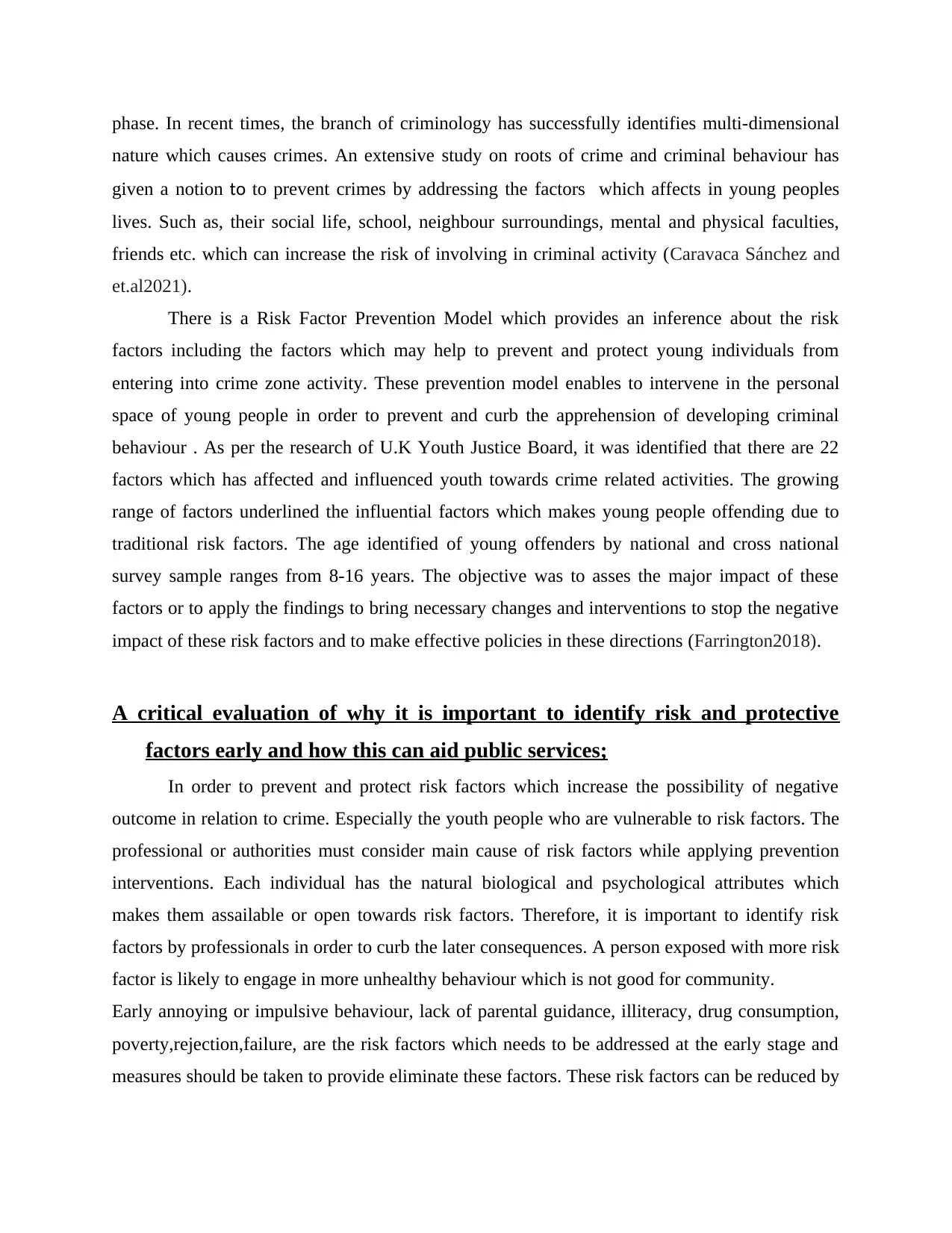
phase. In recent times, the branch of criminology has successfully identifies multi-dimensional
nature which causes crimes. An extensive study on roots of crime and criminal behaviour has
given a notion to to prevent crimes by addressing the factors which affects in young peoples
lives. Such as, their social life, school, neighbour surroundings, mental and physical faculties,
friends etc. which can increase the risk of involving in criminal activity (Caravaca Sánchez and
et.al2021).
There is a Risk Factor Prevention Model which provides an inference about the risk
factors including the factors which may help to prevent and protect young individuals from
entering into crime zone activity. These prevention model enables to intervene in the personal
space of young people in order to prevent and curb the apprehension of developing criminal
behaviour . As per the research of U.K Youth Justice Board, it was identified that there are 22
factors which has affected and influenced youth towards crime related activities. The growing
range of factors underlined the influential factors which makes young people offending due to
traditional risk factors. The age identified of young offenders by national and cross national
survey sample ranges from 8-16 years. The objective was to asses the major impact of these
factors or to apply the findings to bring necessary changes and interventions to stop the negative
impact of these risk factors and to make effective policies in these directions (Farrington2018).
A critical evaluation of why it is important to identify risk and protective
factors early and how this can aid public services;
In order to prevent and protect risk factors which increase the possibility of negative
outcome in relation to crime. Especially the youth people who are vulnerable to risk factors. The
professional or authorities must consider main cause of risk factors while applying prevention
interventions. Each individual has the natural biological and psychological attributes which
makes them assailable or open towards risk factors. Therefore, it is important to identify risk
factors by professionals in order to curb the later consequences. A person exposed with more risk
factor is likely to engage in more unhealthy behaviour which is not good for community.
Early annoying or impulsive behaviour, lack of parental guidance, illiteracy, drug consumption,
poverty,rejection,failure, are the risk factors which needs to be addressed at the early stage and
measures should be taken to provide eliminate these factors. These risk factors can be reduced by
nature which causes crimes. An extensive study on roots of crime and criminal behaviour has
given a notion to to prevent crimes by addressing the factors which affects in young peoples
lives. Such as, their social life, school, neighbour surroundings, mental and physical faculties,
friends etc. which can increase the risk of involving in criminal activity (Caravaca Sánchez and
et.al2021).
There is a Risk Factor Prevention Model which provides an inference about the risk
factors including the factors which may help to prevent and protect young individuals from
entering into crime zone activity. These prevention model enables to intervene in the personal
space of young people in order to prevent and curb the apprehension of developing criminal
behaviour . As per the research of U.K Youth Justice Board, it was identified that there are 22
factors which has affected and influenced youth towards crime related activities. The growing
range of factors underlined the influential factors which makes young people offending due to
traditional risk factors. The age identified of young offenders by national and cross national
survey sample ranges from 8-16 years. The objective was to asses the major impact of these
factors or to apply the findings to bring necessary changes and interventions to stop the negative
impact of these risk factors and to make effective policies in these directions (Farrington2018).
A critical evaluation of why it is important to identify risk and protective
factors early and how this can aid public services;
In order to prevent and protect risk factors which increase the possibility of negative
outcome in relation to crime. Especially the youth people who are vulnerable to risk factors. The
professional or authorities must consider main cause of risk factors while applying prevention
interventions. Each individual has the natural biological and psychological attributes which
makes them assailable or open towards risk factors. Therefore, it is important to identify risk
factors by professionals in order to curb the later consequences. A person exposed with more risk
factor is likely to engage in more unhealthy behaviour which is not good for community.
Early annoying or impulsive behaviour, lack of parental guidance, illiteracy, drug consumption,
poverty,rejection,failure, are the risk factors which needs to be addressed at the early stage and
measures should be taken to provide eliminate these factors. These risk factors can be reduced by
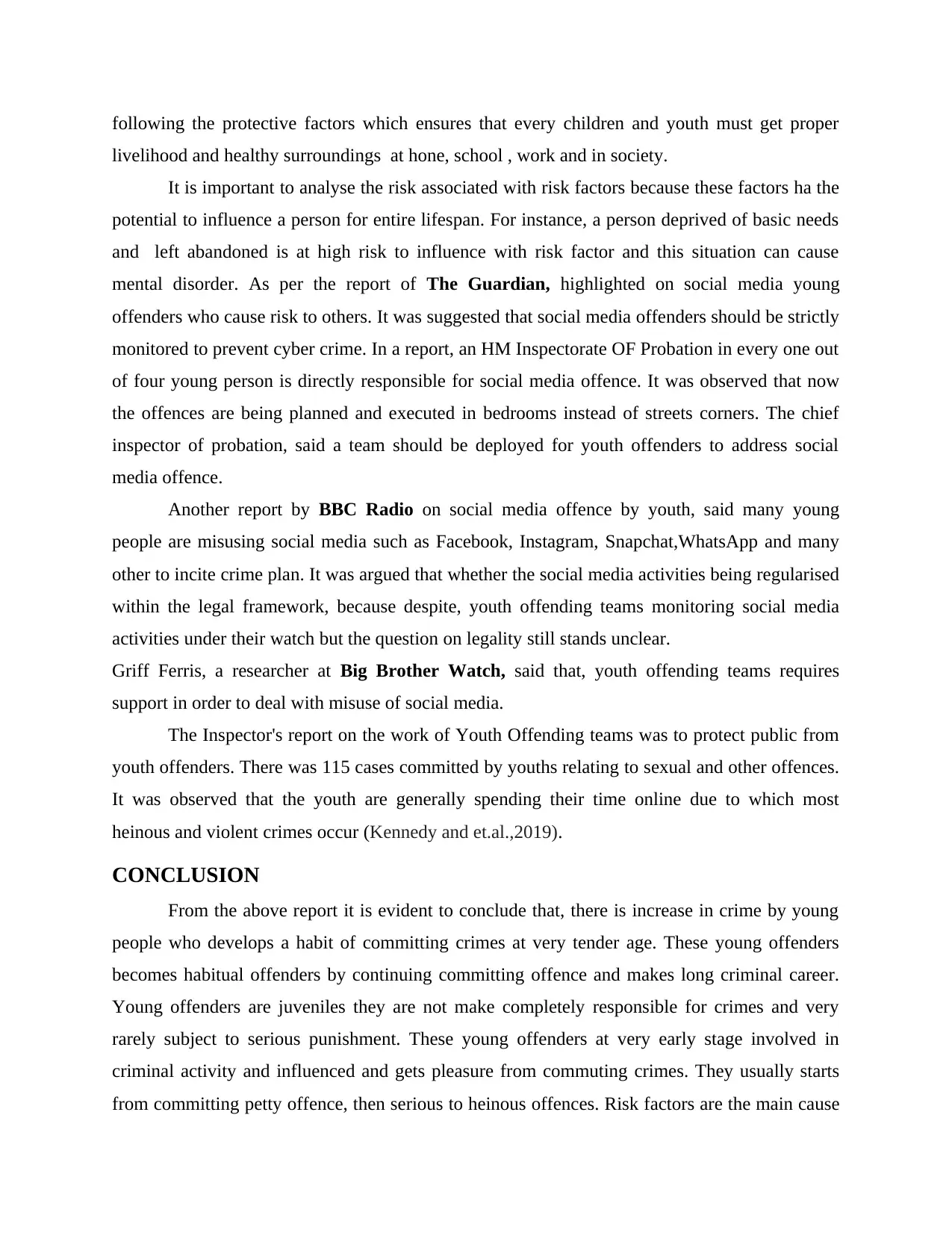
following the protective factors which ensures that every children and youth must get proper
livelihood and healthy surroundings at hone, school , work and in society.
It is important to analyse the risk associated with risk factors because these factors ha the
potential to influence a person for entire lifespan. For instance, a person deprived of basic needs
and left abandoned is at high risk to influence with risk factor and this situation can cause
mental disorder. As per the report of The Guardian, highlighted on social media young
offenders who cause risk to others. It was suggested that social media offenders should be strictly
monitored to prevent cyber crime. In a report, an HM Inspectorate OF Probation in every one out
of four young person is directly responsible for social media offence. It was observed that now
the offences are being planned and executed in bedrooms instead of streets corners. The chief
inspector of probation, said a team should be deployed for youth offenders to address social
media offence.
Another report by BBC Radio on social media offence by youth, said many young
people are misusing social media such as Facebook, Instagram, Snapchat,WhatsApp and many
other to incite crime plan. It was argued that whether the social media activities being regularised
within the legal framework, because despite, youth offending teams monitoring social media
activities under their watch but the question on legality still stands unclear.
Griff Ferris, a researcher at Big Brother Watch, said that, youth offending teams requires
support in order to deal with misuse of social media.
The Inspector's report on the work of Youth Offending teams was to protect public from
youth offenders. There was 115 cases committed by youths relating to sexual and other offences.
It was observed that the youth are generally spending their time online due to which most
heinous and violent crimes occur (Kennedy and et.al.,2019).
CONCLUSION
From the above report it is evident to conclude that, there is increase in crime by young
people who develops a habit of committing crimes at very tender age. These young offenders
becomes habitual offenders by continuing committing offence and makes long criminal career.
Young offenders are juveniles they are not make completely responsible for crimes and very
rarely subject to serious punishment. These young offenders at very early stage involved in
criminal activity and influenced and gets pleasure from commuting crimes. They usually starts
from committing petty offence, then serious to heinous offences. Risk factors are the main cause
livelihood and healthy surroundings at hone, school , work and in society.
It is important to analyse the risk associated with risk factors because these factors ha the
potential to influence a person for entire lifespan. For instance, a person deprived of basic needs
and left abandoned is at high risk to influence with risk factor and this situation can cause
mental disorder. As per the report of The Guardian, highlighted on social media young
offenders who cause risk to others. It was suggested that social media offenders should be strictly
monitored to prevent cyber crime. In a report, an HM Inspectorate OF Probation in every one out
of four young person is directly responsible for social media offence. It was observed that now
the offences are being planned and executed in bedrooms instead of streets corners. The chief
inspector of probation, said a team should be deployed for youth offenders to address social
media offence.
Another report by BBC Radio on social media offence by youth, said many young
people are misusing social media such as Facebook, Instagram, Snapchat,WhatsApp and many
other to incite crime plan. It was argued that whether the social media activities being regularised
within the legal framework, because despite, youth offending teams monitoring social media
activities under their watch but the question on legality still stands unclear.
Griff Ferris, a researcher at Big Brother Watch, said that, youth offending teams requires
support in order to deal with misuse of social media.
The Inspector's report on the work of Youth Offending teams was to protect public from
youth offenders. There was 115 cases committed by youths relating to sexual and other offences.
It was observed that the youth are generally spending their time online due to which most
heinous and violent crimes occur (Kennedy and et.al.,2019).
CONCLUSION
From the above report it is evident to conclude that, there is increase in crime by young
people who develops a habit of committing crimes at very tender age. These young offenders
becomes habitual offenders by continuing committing offence and makes long criminal career.
Young offenders are juveniles they are not make completely responsible for crimes and very
rarely subject to serious punishment. These young offenders at very early stage involved in
criminal activity and influenced and gets pleasure from commuting crimes. They usually starts
from committing petty offence, then serious to heinous offences. Risk factors are the main cause
⊘ This is a preview!⊘
Do you want full access?
Subscribe today to unlock all pages.

Trusted by 1+ million students worldwide

for making young people offenders. In this report, all the relevant extract and information
relating to cause of young people crime considering the risk factors and protective factors. A
proper explanations on risk factor and protective factor along with relevant examples has been
provided in this report. This report is equipped with effective suggestion to prevent youth crimes
and to ensure safety in society by application of preventive policies.
relating to cause of young people crime considering the risk factors and protective factors. A
proper explanations on risk factor and protective factor along with relevant examples has been
provided in this report. This report is equipped with effective suggestion to prevent youth crimes
and to ensure safety in society by application of preventive policies.
Paraphrase This Document
Need a fresh take? Get an instant paraphrase of this document with our AI Paraphraser
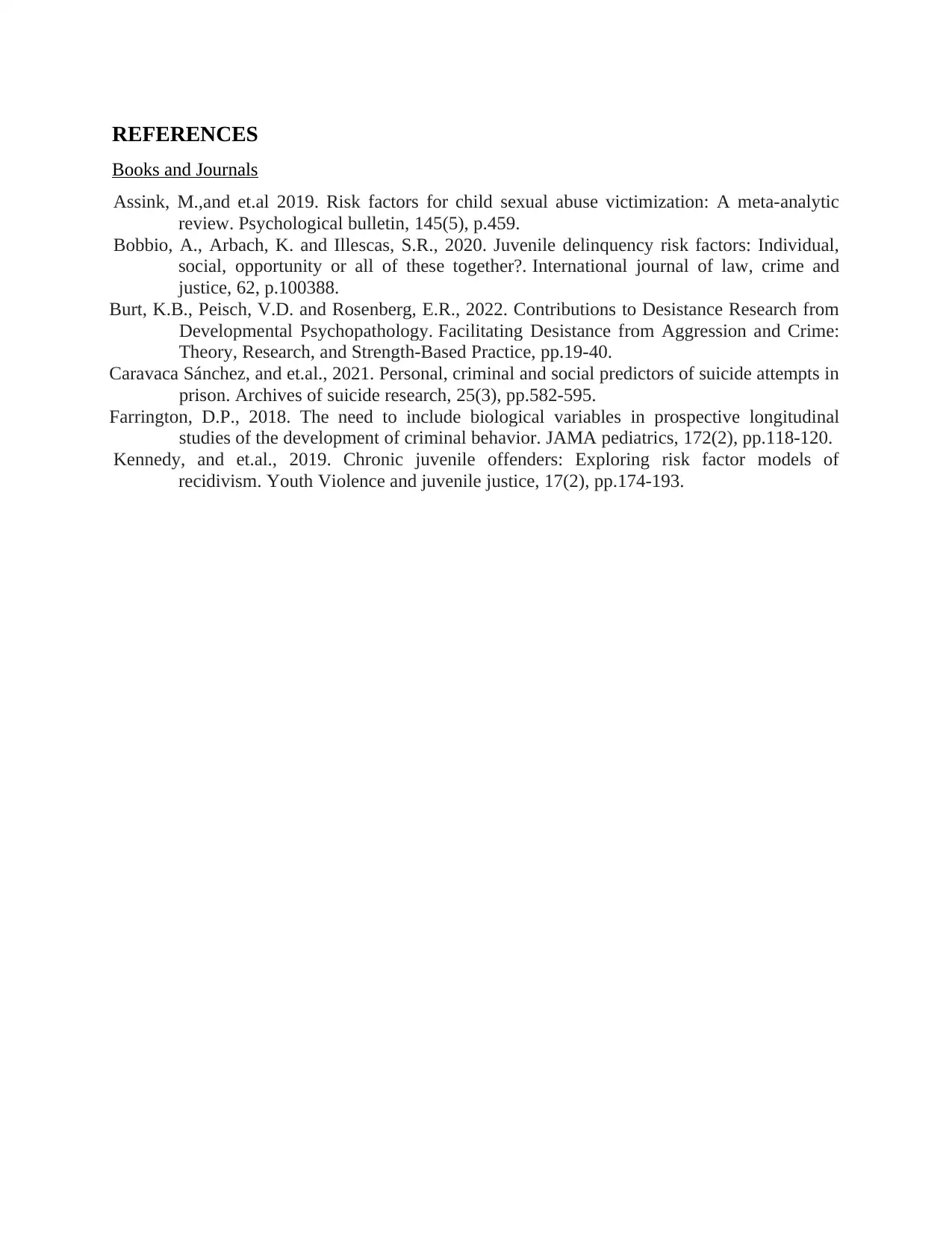
REFERENCES
Books and Journals
Assink, M.,and et.al 2019. Risk factors for child sexual abuse victimization: A meta-analytic
review. Psychological bulletin, 145(5), p.459.
Bobbio, A., Arbach, K. and Illescas, S.R., 2020. Juvenile delinquency risk factors: Individual,
social, opportunity or all of these together?. International journal of law, crime and
justice, 62, p.100388.
Burt, K.B., Peisch, V.D. and Rosenberg, E.R., 2022. Contributions to Desistance Research from
Developmental Psychopathology. Facilitating Desistance from Aggression and Crime:
Theory, Research, and Strength‐Based Practice, pp.19-40.
Caravaca Sánchez, and et.al., 2021. Personal, criminal and social predictors of suicide attempts in
prison. Archives of suicide research, 25(3), pp.582-595.
Farrington, D.P., 2018. The need to include biological variables in prospective longitudinal
studies of the development of criminal behavior. JAMA pediatrics, 172(2), pp.118-120.
Kennedy, and et.al., 2019. Chronic juvenile offenders: Exploring risk factor models of
recidivism. Youth Violence and juvenile justice, 17(2), pp.174-193.
Books and Journals
Assink, M.,and et.al 2019. Risk factors for child sexual abuse victimization: A meta-analytic
review. Psychological bulletin, 145(5), p.459.
Bobbio, A., Arbach, K. and Illescas, S.R., 2020. Juvenile delinquency risk factors: Individual,
social, opportunity or all of these together?. International journal of law, crime and
justice, 62, p.100388.
Burt, K.B., Peisch, V.D. and Rosenberg, E.R., 2022. Contributions to Desistance Research from
Developmental Psychopathology. Facilitating Desistance from Aggression and Crime:
Theory, Research, and Strength‐Based Practice, pp.19-40.
Caravaca Sánchez, and et.al., 2021. Personal, criminal and social predictors of suicide attempts in
prison. Archives of suicide research, 25(3), pp.582-595.
Farrington, D.P., 2018. The need to include biological variables in prospective longitudinal
studies of the development of criminal behavior. JAMA pediatrics, 172(2), pp.118-120.
Kennedy, and et.al., 2019. Chronic juvenile offenders: Exploring risk factor models of
recidivism. Youth Violence and juvenile justice, 17(2), pp.174-193.
1 out of 8
Related Documents
Your All-in-One AI-Powered Toolkit for Academic Success.
+13062052269
info@desklib.com
Available 24*7 on WhatsApp / Email
![[object Object]](/_next/static/media/star-bottom.7253800d.svg)
Unlock your academic potential
Copyright © 2020–2025 A2Z Services. All Rights Reserved. Developed and managed by ZUCOL.




